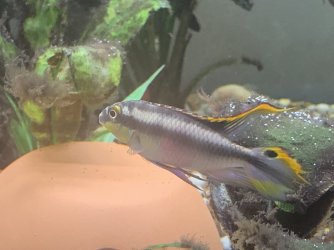What are the tank dimensions (length x width x height)?
How long has the tank been set up for?
What other fish are in the tank?
What is the ammonia, nitrite, nitrate and pH of the water (in numbers)?
What sort of filter is on the aquarium?
How often and how do you clean the filter?
How often do you do water changes and how much do you change?
Do you gravel clean the substrate when you do a water change?
--------------------
It could be fin rot but that s normally caused by poor water quality (ammonia or nitrite). If there is any ammonia or nitrite in the water, or a high nitrate, that can stop the fin from healing. If the water is good, then add some salt and see if it improves over a week.
If it doesn't improve after a week with salt then look for a broad spectrum medication that treats bacteria and fungus (not an antibiotic tho and not Melafix or Pimafix because they won't help).
--------------------
SALT
You can add rock salt (often sold as aquarium salt), swimming pool salt, or any non iodised salt (sodium chloride) to the aquarium at the dose rate of 1 heaped tablespoon per 20 litres (5 gallons) of water. If there is no improvement after 48 hours you can double that dose rate so there is 2 heaped tablespoons of salt per 20 litres.
Keep the salt level like this for at least 2 weeks but no longer than 4 weeks otherwise kidney damage can occur. Kidney damage is more likely to occur in fish from soft water (tetras, Corydoras, angelfish, Bettas & gouramis, loaches) that are exposed to high levels of salt for an extended period of time, and is not an issue with livebearers, rainbowfish or other salt tolerant species.
The salt will not affect the beneficial filter bacteria, fish, plants, shrimp or snails.
After you use salt and the fish have recovered, you do a 10% water change each day for a week using only fresh water that has been dechlorinated. Then do a 20% water change each day for a week. Then you can do bigger water changes after that. This dilutes the salt out of the tank slowly so it doesn't harm the fish.
If you do water changes while using salt, you need to treat the new water with salt before adding it to the tank. This will keep the salt level stable in the tank and minimise stress on the fish.
When you first add salt, add the salt to a small bucket of tank water and dissolve the salt. Then slowly pour the salt water into the tank near the filter outlet. Add the salt over a couple of minutes.



